It seems that in order to commemorate this significant 10th anniversary, ETH is once again challenging the $4000 mark.
From the mainnet launch on July 30, 2015, to today in 2025, over the course of ten years, it has not only witnessed the rise and fall of the entire blockchain industry but has also built an unprecedented "world computer" through numerous upgrades and consensus. Once underestimated, smart contracts have now become the most universal operating system in the Web3 world. ETH has also grown from a few cents during its crowdfunding phase to a major asset with a market capitalization exceeding $300 billion.
At the same time, the Ethereum Foundation has also undergone a significant "blood transfusion." Internally, changes are happening, and externally, things are shifting as well. Over the past year, a number of companies with traditional financial backgrounds have successively purchased ETH, with institutions like SharpLink, BTCS, and BMNR announcing that they will include ETH in their strategic asset reserves.
All these changes are occurring in this special year: 2025, marking the tenth anniversary of the Ethereum mainnet launch.
This decade is the most colorful chapter in the history of blockchain. From a white paper to a global ecosystem worth hundreds of billions of dollars; from the "Eight Kings' Governance" of the founding team to the breakout of an island amidst the siege of "Ethereum Killers"; from PoW to PoS, from a technical laboratory to public infrastructure, Ethereum has completed its first cycle.
But its real story may just be beginning.
The "Prequel" of Ethereum
This phase focuses on the split and ideological conflicts within the Ethereum founding team, occurring between 2014 and 2015. Vitalik Buterin, the programmer genius who always speaks eloquently about technology, often responds that his biggest regret in the Ethereum journey is "the matter of the 8 co-founders." Clearly, these 8 co-founders who have long since departed are a concern for him.
When Vitalik had nothing but an idea, he welcomed the first 10 developers who responded to his invitation to join and selected 5 of them to form the leadership, which are the 5 co-founders of Ethereum: Vitalik Buterin, Anthony Di Iorio, Charles Hoskinson, Mihai Alisie, and Amir Chetrit.
"This was obviously a very serious mistake. They looked like good people, and they wanted to help, so at the time I thought, why not let them be in leadership?" Vitalik reflected on his decision at that time.
The topic of Ethereum's co-founders is a controversial one, with many versions circulating online, and even the relevant entries on Wikipedia are constantly being edited. After Vitalik "certified the 8 co-founders," the widely accepted version in the community is that, following the 5 founders, three more developers became co-founders in 2014: Joseph Lubin, Gavin Wood, and Jeffrey Wilcke.
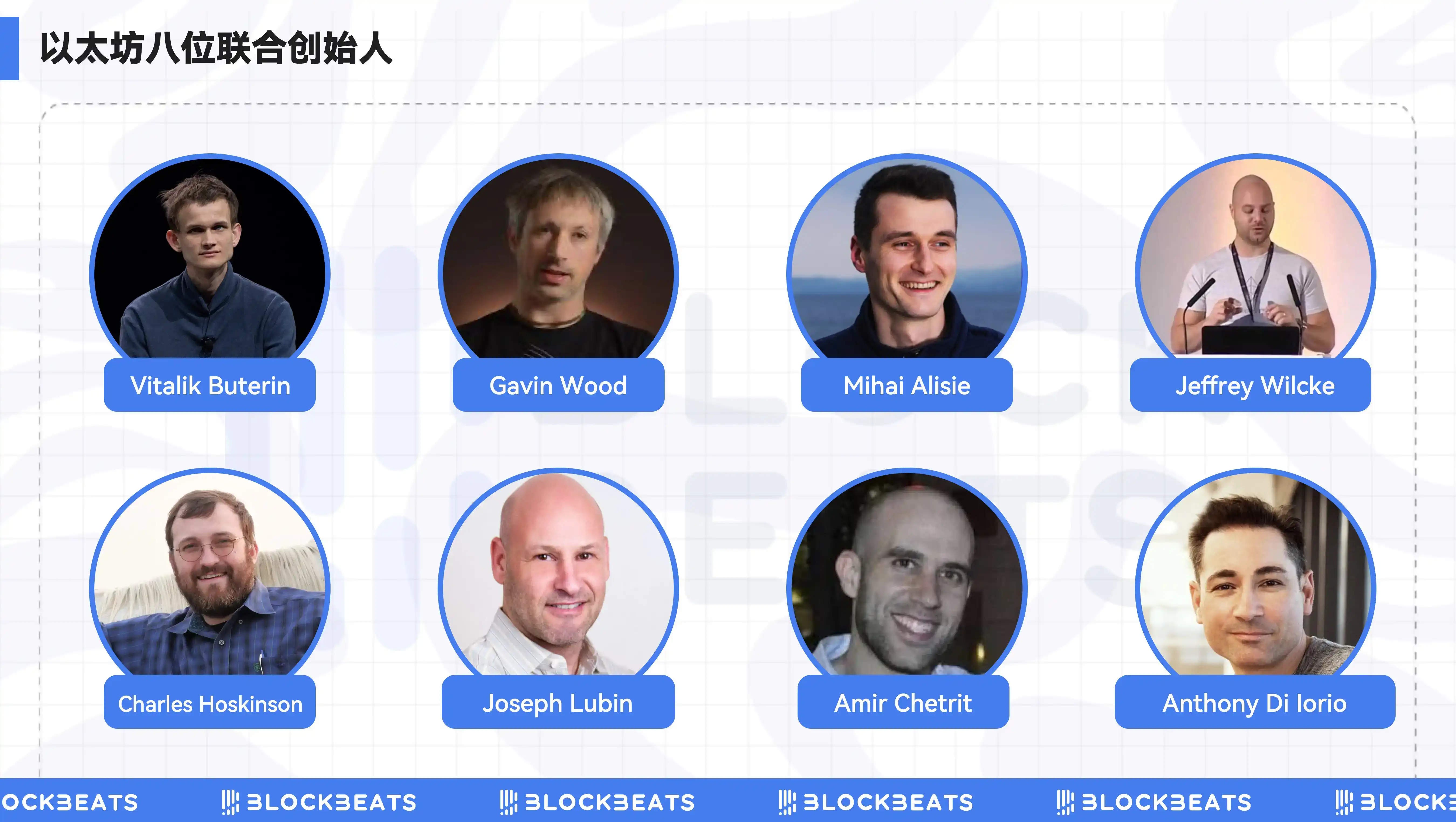
Thus, Ethereum completed the formation of its early 8 core leaders, resembling the "Eight Kings' Governance" implemented in the early Yuan and Qing dynasties to prevent the emperor (Khan) from acting arbitrarily.
Berlin "Pilgrimage"
In the documentary "Vitalik: An Ethereum Story," which launched last year, Vitalik recalled that he began his digital nomad life in mid-2013.
That was the prehistoric period of Ethereum, when Bitcoin was only $204, more than a year after Vitalik and Mihai Alisie founded Bitcoin Magazine. While building Ethereum, he traveled around the world due to invitations from various communities. In 2013 and 2014, Ethereum established headquarters in Switzerland and Berlin, the white paper was published, and Vitalik visited China to crowdfund for Ethereum, meeting miners.
Berlin was the city where he stayed the longest.
"Pilgrimage," Vitalik described his active life in the Bitcoin Kiez area of Berlin at that time. In the Bitcoin Kiez area of Berlin, cryptocurrency payments were very common. Within a few hundred meters, there were dozens of stores accepting BTC payments. The community center "Room 77" was also a hub where various people, including tech developers and political activists, frequently visited.

Room 77, photographed by Vitalik Buterin in 2013, is now closed.
In this area, Ethereum rented an office just 1.5 kilometers from "Room 77," which Vitalik could walk to in under 20 minutes. Now, if you search for the address of the Ethereum office "Waldemarstraße 37A, 10999 Berlin" on Google Maps, you can still see this address marked as Ethereum Network Launch (30/07/2015), along with a group photo of the early core members of Ethereum.
In early 2014, most of Ethereum's core members were basically around Vitalik, and the Ethereum team was in a highly cohesive state.
At the Bitcoin conference in Miami in January of that year, Vitalik and his co-founders stood together for the first time to showcase their project to the world, which had a good effect, officially bringing Ethereum into the public eye. However, this was also the eve of separation.
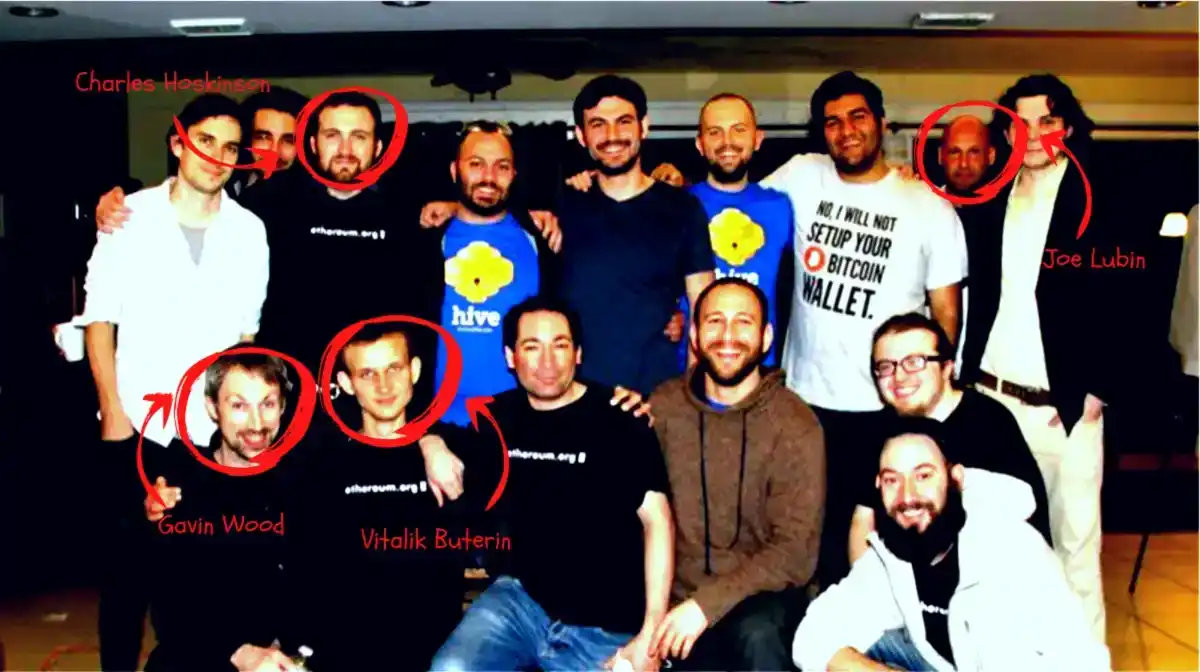
The first Ethereum meetup held in Miami in January 2014, image source: internet
Swiss Split
The entire year of 2014 was not ordinary for the crypto world; the Mt. Gox hack and bankruptcy caused Bitcoin's price to plummet from a peak of $951.39 to $309.87, a drop of 67%. It was also the year when CZ sold his house in Shanghai and went all-in on Bitcoin at $600 to become the CTO of OK. SBF, who had just graduated from MIT, was applying for jobs on Wall Street.
For Ethereum, 2014 was an even more significant year, staging a crypto version of the "Silicon Valley Eight Immortals' Departure," where the split at this meeting determined the future direction of Ethereum.
On June 7, 2014, all leadership members of Ethereum attended an internal meeting in Switzerland, focusing on discussing the future direction of Ethereum. The meeting was held at the Spaceship house in Switzerland, the origin of ETH and Ethereum's first headquarters.

Spaceship house, image source: Mihai Alisie
In fact, prior to this meeting, this topic had already been debated internally for a long time, and factions had already emerged. The internal relationships within Ethereum became tense, with ongoing debates about whether to use venture capital funds or to crowdfund from ordinary people; whether to pursue a profit model and become the Google of the crypto world or to remain a purely non-profit organization.
Vitalik recalled this memory, saying, "I was once persuaded to lean towards making Ethereum more corporate. But this never made me feel comfortable; it even felt a bit dirty."
It is said that this meeting, which determined Ethereum's "life and death," lasted an entire day, and Vitalik's decision was to choose the decentralized and non-profit route. "I was trying to shirk responsibility throughout the process because I really didn't want to take responsibility, and in the end, I had to clear out some people."
This decision became the first turning point in Ethereum's history, directly leading to the team's first major split.
Charles Hoskinson was the most prominent opponent in this conflict, consistently advocating that Ethereum should become a commercial company, obtain funding through venture capital, and later develop into a profitable tech giant. "A horizontal power structure, where janitors and executives are on the same level, is simply insane."
After leaving Ethereum, Charles founded the development company IOHK (later restructured into a venture capital studio) and launched a PoS public chain called Cardano. This became a leading altcoin for many years, often referred to as the "Japanese Ethereum" due to its early focus on the Japanese market, and it was also the first generation of "Ethereum Killers," consistently ranking in the top ten by market capitalization.
Following Charles Hoskinson, Joseph Lubin also decided to step back from core development and turned to establish the incubator ConsenSys, which completed a $450 million Series D funding round in 2022 at a valuation of $7 billion, with investors including ParaFi Capital, Temasek, SoftBank Vision Fund II, and Microsoft among top VCs. Over the years, ConsenSys has incubated numerous blockchain startups and built a rich array of ecological projects for Ethereum, the most successful of which is the plugin wallet MetaMask, the most commonly used wallet in the Ethereum ecosystem, generating weekly revenues of $300,000 and total revenues nearing $300 million.
Similar to Joseph Lubin, Anthony was also a wealthy second-generation individual, and his involvement in Ethereum was primarily to make more money. Therefore, after Ethereum established a non-profit operating model, Anthony gradually began to step back, entering a semi-retirement state, creating Decentral and developing the Jaxx digital wallet (ultimately confirming his departure from Ethereum in December 2015). In 2018, Forbes estimated his net worth to be between $750 million and $1 billion, placing him among the top 20 wealthiest individuals in the cryptocurrency field. However, in 2021, he announced that for personal safety reasons, he decided to "liquidate" and exit the space, no longer funding any blockchain projects, and planned to focus on charity and other endeavors.
As for Amir Chetrit, he left due to a lack of investment in Ethereum and was criticized by other developers and founders at the Swiss meeting, later venturing into other industries. He has remained anonymous and focused on privacy protection, with very little information available about him.
By the end of 2014, when the dust settled, only four of the original eight co-founders remained in the team: Vitalik Buterin, Gavin Wood, Mihai Alisie, and Jeffrey Wilcke.
Vitalik has also reflected on his haste in selecting the team, failing to consider the deep-seated differences among members, the conflicts of ideology, and the clashes of interests, which turned out to be far more complex than he initially envisioned. "I did realize at that time that not everyone in the cryptocurrency space is like me, fighting for ideals; many people are indeed just looking to make a lot of money. The relationships between people are a real issue."
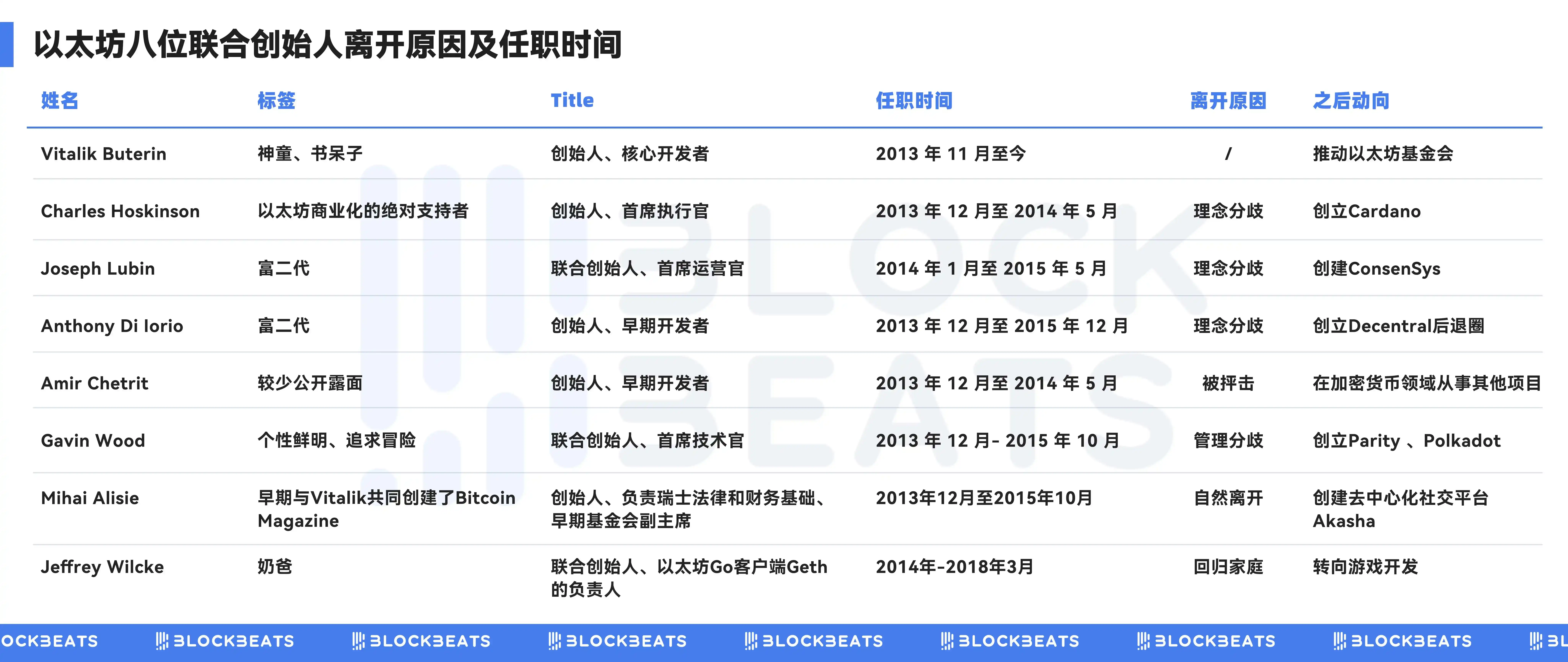
Work had to continue, and Vitalik and the others who remained began to move forward. Fortunately for Vitalik, the foundation was taking on more responsibilities at that time, and his most important technical partner, Gavin Wood, was still fighting alongside him.
The Tumultuous Foundation
July 30, 2015, was a historic moment for the launch of the Ethereum mainnet.
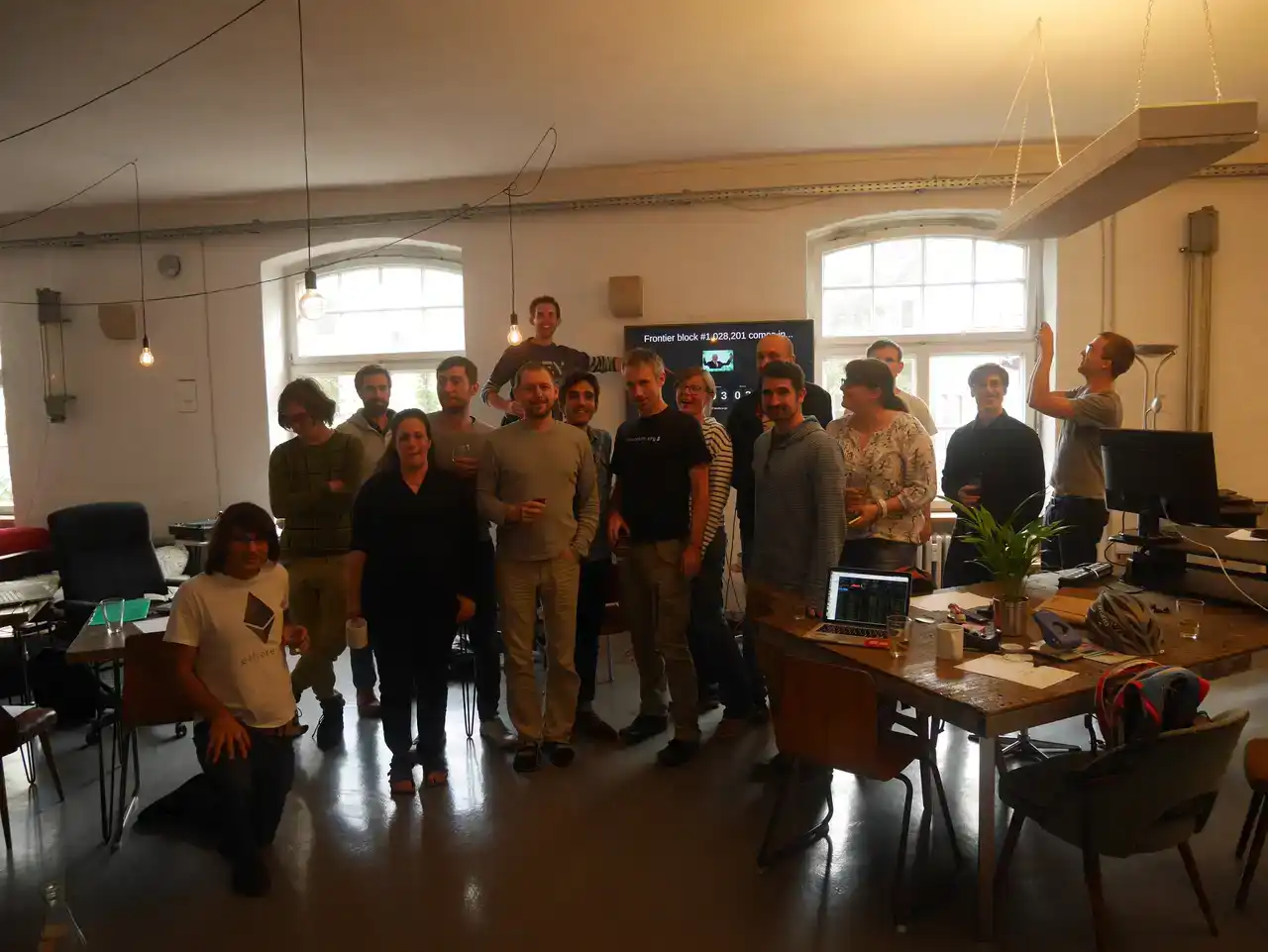
Some early members gathered in the Berlin office to witness the automatic activation of Ethereum after block 1028201. A highly significant photo captured some of the core members at that time. Among those in the frame with Vitalik were several notable core developers, including:
Gustav Simonsson, an early security advisor for Ethereum, played a crucial role in the security of the Ethereum mainnet. After leaving Ethereum, he joined Dfinity, continuing to delve into the field of decentralized computing networks.
Christian Reitwiessner, the developer of the Solidity programming language, provided the foundation for running smart contracts on Ethereum.
Among the Solidity development team, Liana Husikyan was also an important member, being one of the main developers of Remix IDE. Remix is an integrated development environment for writing and deploying smart contracts, helping to simplify the development process of smart contracts.
At the same time, Christoph Jentzsch was the founder of Slock.it and one of the initiators of The DAO. Although it forked in 2016 due to security vulnerabilities, The DAO remains one of the most important experiments in blockchain history, promoting the exploration of decentralized governance models.
Additionally, there were authors of ERC 20 and ERC 725, Fabian Vogelsteller, Vlad Zamfir, who facilitated Ethereum's transition from proof of work (PoW) to proof of stake, and Jutta Steiner, the security head of the Ethereum Foundation (who later became the CEO of Parity Technologies, founded by Gavin).
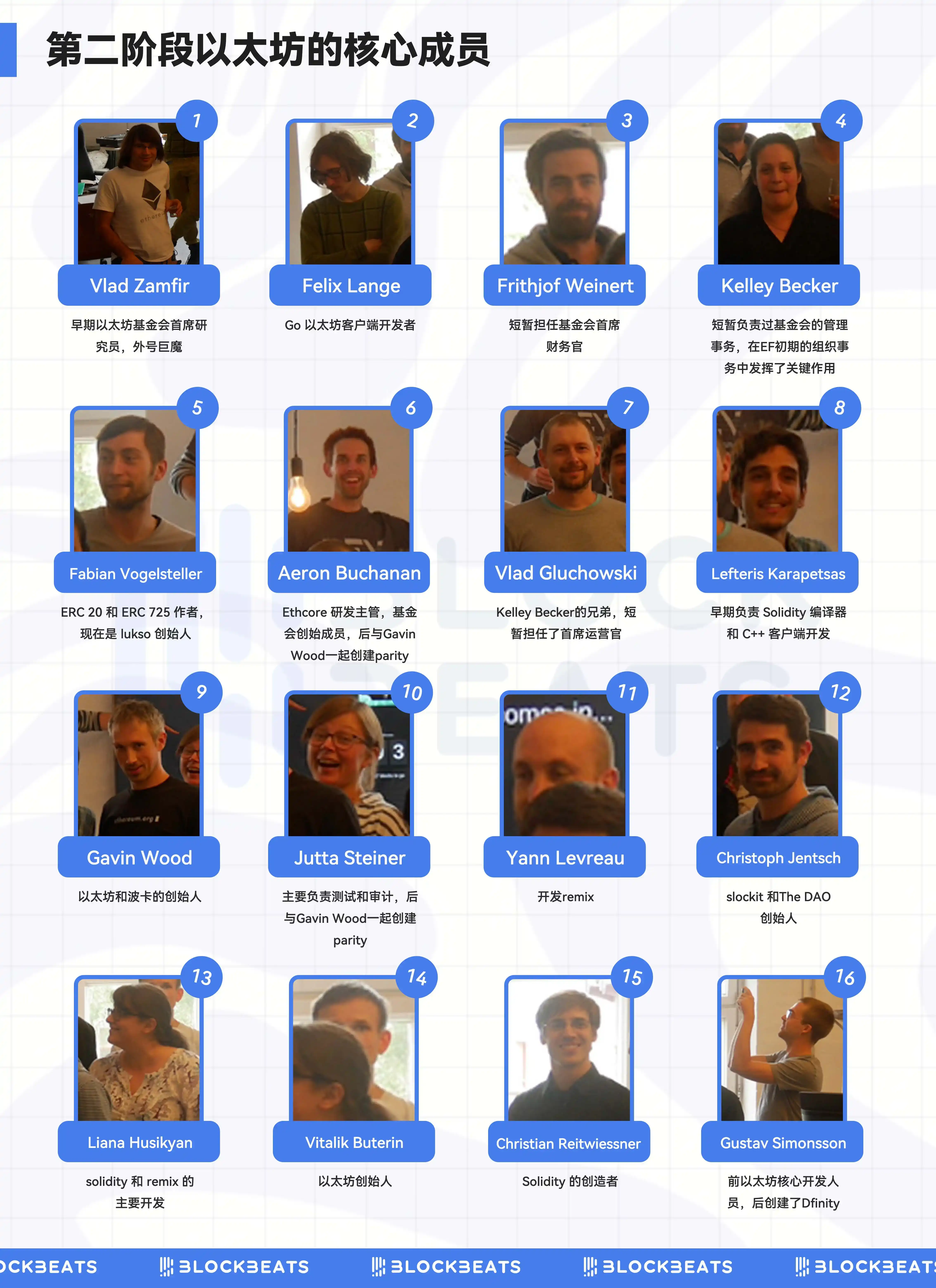
Also, there is a detail in this photo that is often talked about: Vitalik is hiding in the corner of the photo, half of his face obscured, while his most important technical partner, Gavin Wood, is in the center of the photo, looking more like a proper CEO.
In some past photos, we can also see the close collaborative relationship between Vitalik and Gavin. However, no one anticipated that this leader of the Ethereum engineering team and the author of the Ethereum yellow paper would be one of those to leave soon after.
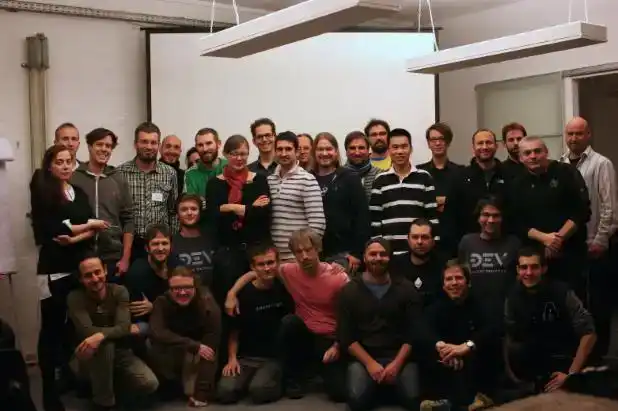
On November 28, 2014, the Ethereum Berlin office hosted the first DEVCON developer conference, where most members gathered in Berlin for the first time after previously communicating via Skype. The photos from the meeting show Vitalik and Gavin still embracing each other as usual.
Just three months after the mainnet launch, Gavin Wood chose to leave, believing that Ethereum needed a more centralized engineering management model to be more efficient. However, Vitalik once again said "NO." The significant disagreement ultimately led to Gavin leaving the team and founding his own company—Parity (Ethcore). Parity quickly became an important node operator in the Ethereum network, at one point controlling over 40% of the network nodes. Subsequently, Gavin fully promoted the development of Polkadot, which became one of Ethereum's significant competitors for a long time.
Gavin's departure directly weakened Ethereum's engineering capabilities; his leadership and technical expertise were crucial in the early development of Ethereum. With his departure, the team's efficiency issues gradually became apparent. The developers of Ethereum's Geth client were distributed globally, leading to frequent management and coordination problems, which affected the development progress.
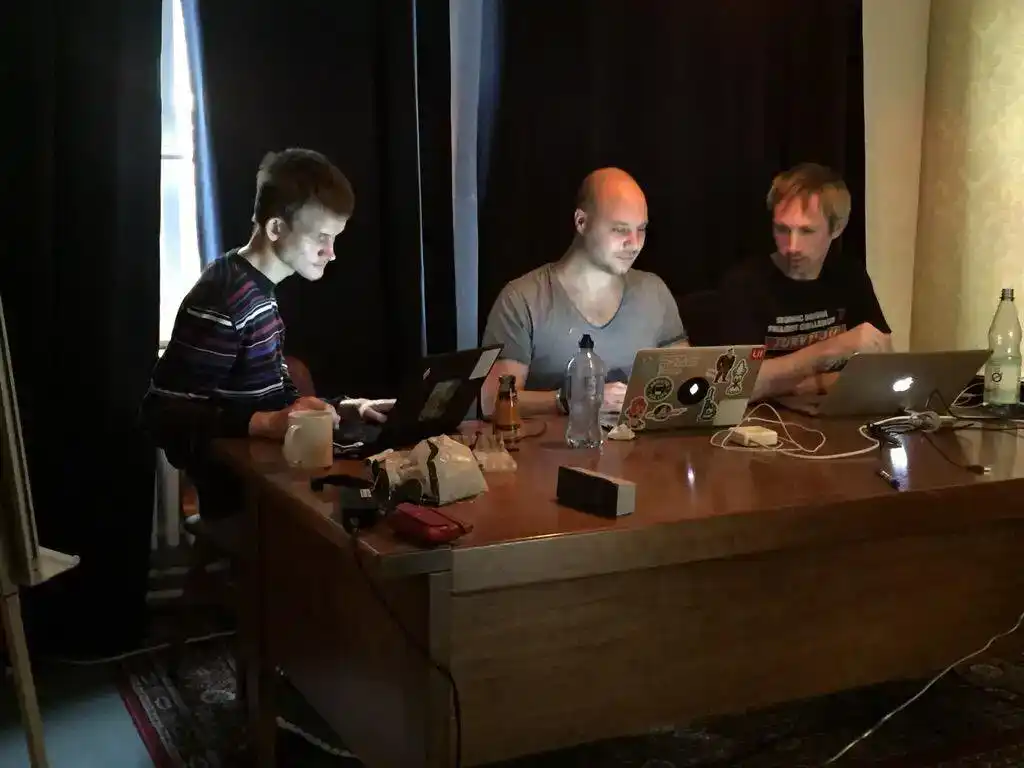
Vitalik, Jeff, Gavin, image source: Vitalik
However, after Gavin left, the remaining two co-founders, Mihai Alisie and Jeffrey Wilcke, also left during this period.
Mihai Alisie was one of Vitalik's earliest partners; the two co-founded Bitcoin Magazine. He assisted Ethereum in establishing a legal framework in Switzerland and served as the vice chairman of the foundation. Mihai's departure was relatively natural; he did not have intense conflicts with the team, but the core strength of Ethereum's early construction further diminished.
Jeffrey Wilcke gradually exited after The DAO was hacked, resulting in a significant ETH theft that led to Ethereum's fork. He handed over the development work and technical oversight of the Ethereum Go client, Geth, to his assistant Péter Szilágyi, redirecting his focus to game development and spending time with his family, around March 2018.

Jeffrey Wilcke taking care of his child, image source: internet
With the departure of these founding members, Vitalik's sense of loneliness within Ethereum grew day by day. Developers revealed that 2015 was a lonely and difficult year for Vitalik, as he often spent nights in the Berlin office.
The First Generation Foundation
At its inception, many members of the Ethereum Foundation were appointed on a temporary basis. For example, Kelley Becker and Frithjof Weinert briefly served as the chief operating officer and chief financial officer of the Ethereum Foundation, respectively, responsible for the foundation's daily operations and financial management, ensuring that the foundation had sufficient funds to support Ethereum's development and operations. However, their tenures were short-lived, and they soon left the foundation.
In 2015, while Ethereum was undergoing large-scale recruitment, the foundation also took on more responsibilities, with core developers being incorporated into the Ethereum Foundation's research team.
By April 10, 2015, the Ethereum Foundation began to establish its organizational structure, initiating board member selection, and its operations gradually got on track. In mid-2015, Ming Chan, who had years of experience in IT and management consulting, was appointed as the new executive director of the Ethereum Foundation, handling the foundation's daily operations to ensure standardized management and that technical development and community operations proceeded smoothly within legal and regulatory frameworks.
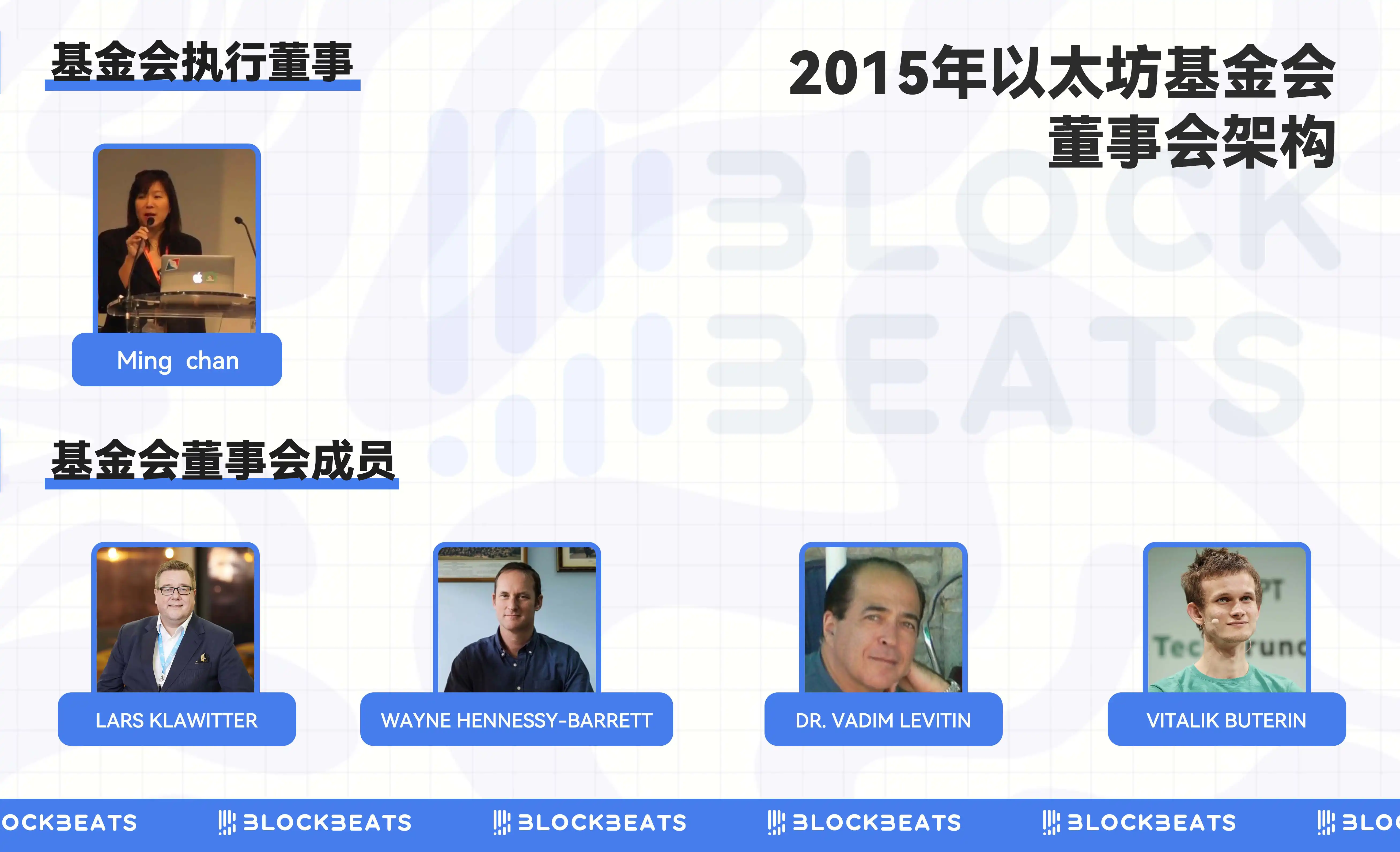
The internal structure of the foundation was further clarified. Besides Vitalik, who remained the core figure in technology and community, Lars Klawitter, Vadim Levitin, and Wayne Hennessy-Barrett also joined the foundation's board.
Lars Klawitter was responsible for integrating technology and innovation within the foundation; he had previously been active as an entrepreneur during the internet revolution and served as the head of innovation at Rolls-Royce. Vadim Levitin was a technical expert with extensive international experience who had worked for the United Nations, helping the Ethereum Foundation expand its influence globally. Wayne Hennessy-Barrett was another board member who brought a global perspective to the foundation, with rich operational experience in emerging markets in Africa.
With the addition of these new members, the Ethereum Foundation gradually improved its governance structure, and the core tasks of the foundation shifted from technical development to community coordination and resource allocation.
At that time, the foundation still held a large amount of ETH assets and supported the development of the Ethereum ecosystem by funding various research projects and developer teams.
The Second Generation Foundation
In 2018, the cryptocurrency space had experienced the explosive growth of ICOs and the significant crash of 94, marking the "regulatory clearing year" for cryptocurrencies. Bitcoin's price fell from a peak of $19,870 to around $3,000, and Binance emerged as the largest trading platform globally. It would be another two years before the "Ethereum Killer," Solana, was launched.
When people talked about Ethereum, they generally mentioned two things: the upgrade to Ethereum 2.0 and that the Ethereum Foundation had sold tokens again.
The ETH supply controlled by the foundation had been continuously decreasing and selling off over the years, leading to a predominantly negative sentiment among community members. However, some members of the Ethereum Foundation stated that this was one of the signs of the foundation's intentional decentralization, "The EF consciously wants to weaken its influence and role, which is a good thing."
Indeed, since Aya Miyaguchi took over as the new executive director of the Ethereum Foundation from Ming Chan in 2018, the foundation has shifted from being the central hub for all development work to focusing more on supporting and coordinating communication and collaboration between different projects, as well as expanding partnerships with external collaborators, such as ConsenSys.
After Aya Miyaguchi took office, the responsibilities of the Ethereum Foundation became clearer, mainly limited to:
- Hosting one Devcon or Devconnect each year;
- Maintaining an execution client, Geth, but not maintaining any consensus clients;
- Providing tens of millions of dollars in unconditional grants to the broader community each year;
- Hosting conference calls: such as All Core Devs (ACD) hosted by Tim Beiko, and All Devs Consensus (ACDC) hosted by Alex Stokes, etc.;
- Conducting research: this may still be one of the more centralized departments, but some EF research teams may become independent;
- Roadmap formulation: Vitalik updated the roadmap illustration, followed by dozens of tasks being developed in parallel by different teams.
Currently, the Ethereum Foundation's official website lists only three leadership members: besides Aya Miyaguchi and Vitalik, there is also a board member, Patrick Storchenegger.
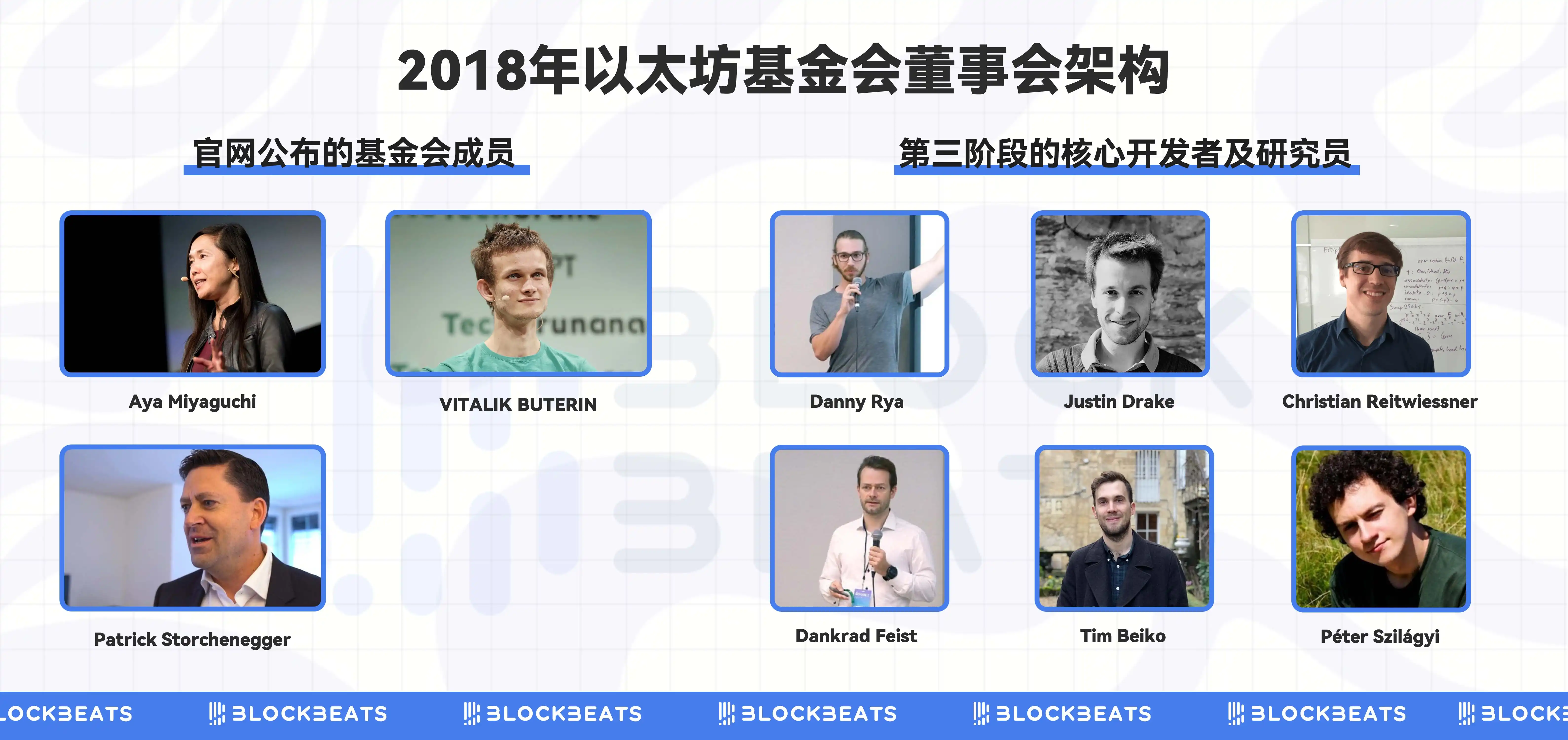
During this period, several new-generation core developers within the Ethereum Foundation gradually emerged as key figures in Ethereum 2.0 and the entire ecosystem. Below is a list of individuals I personally consider important in Ethereum, including: Danny Ryan, Justin Drake, Tim Beiko, Dankrad Feist, Solidity creator Christian Reitwiessner, and Péter Szilágyi, among others. (In my view, there is no specific order, and I won't enumerate them all.)
Danny Ryan is a core member of the Ethereum 2.0 team, hailed by the community as the "Chief Engineer of Ethereum 2.0." He played a crucial role in coordinating the development process of Ethereum 2.0, especially during the launch of the Beacon Chain and the merge upgrade, and he was the first Ethereum Foundation researcher to appear in the documentary "Vitalik: An Ethereum Story."
Since joining the Ethereum Foundation in 2017, Justin Drake's main work has also been focused on Ethereum's transition to proof of stake (PoS), playing a key role in the execution of the ETH merge. Additionally, Justin Drake is one of the main spokespersons in the community regarding Ethereum's future technology roadmap, frequently participating in podcasts and interviews to educate the public. For example, during the Ethereum Foundation's Reddit AMA, Justin Drake was also one of the key speakers, enjoying a solid reputation in the community.
Tim Beiko joined the Ethereum Foundation full-time in 2018 and became one of the leaders of core developers in 2021, responsible for organizing ACD conference calls and serving as an important bridge between Ethereum core developers. As a protocol engineer, his work encompasses the advancement of multiple Ethereum Improvement Proposals (EIPs).
Dankrad Feist is an important researcher at the Ethereum Foundation, focusing on research related to statelessness and data availability. The "Danksharding" concept he proposed is part of Ethereum's sharding technology roadmap, and thus the scaling solution ultimately chosen for the Ethereum mainnet is named after Dankrad Feist. Additionally, his research on MEV (Maximum Extractable Value) has provided new insights into Ethereum's security, although he has had public disputes with Péter Szilágyi, the current lead developer of Geth, on this issue, ultimately forcing Vitalik to mediate.
After solidifying the team members, from 2018 to 2022, the expansion of the Ethereum ecosystem gained mainstream recognition. In 2019, DEXs like Uniswap, Compound, and SushiSwap provided lucrative yields for any DeFi users providing liquidity, and DeFi Summer led to a rapid increase in Ethereum's Total Value Locked (TVL). The year 2021 was dubbed the "century of the metaverse," with Facebook rebranding as Meta, paving the way for the explosion of NFTs. In 2022, the cryptocurrency space experienced a "Lehman moment," with Luna and FTX collapsing one after another, and the Solana ecosystem taking a significant hit, while Ethereum successfully transitioned from PoW to PoS, and the Layer 2 sector thrived, achieving a period of explosive growth.
"Midlife Crisis"
However, as the saying goes, "What goes up must come down." In 2024, Ethereum finally faced its "midlife crisis," with the price stagnating.
2024 is also an important year, marking the 10th anniversary of ICOs. At 10 years old, Apple nearly went bankrupt, with a peak market value of only $20 billion. Microsoft, after ten years of being listed, saw its market value grow from $670 million to $130 billion. Meanwhile, Ethereum's market value stands at $321 billion. Although Ethereum's market value growth over these 10 years has been more rapid than that of nearly all current tech giants, it was even once thought to potentially surpass Bitcoin.
However, there is a rule in finance that when an asset's scale reaches $300 billion or $500 billion, it faces a "growth bottleneck." As the 34th largest asset globally, ETH's market value of $321 billion is currently within this "growth bottleneck." The "vehicle" is too heavy, and the "market" is too dispersed; under such scale, Ethereum's growth is extremely difficult, almost struggling against "gravity."
While Ethereum stagnates, Bitcoin continues to hit new highs, and Solana has "risen from the ashes." No one can succinctly describe the full scope of the issues and stories surrounding the Ethereum Foundation at that time. However, what we do know is that the sluggish performance of ETH's price has kept Ethereum and the Ethereum Foundation in the spotlight for the past couple of years.
As a decentralized non-profit organization, managing Ethereum's internal organizational structure is not easy. Looking back at Ethereum's journey, it started with eight founding teams that had differing philosophies and "separated," playing out a crypto version of "Silicon Valley's eight immortals leaving." Now, against the backdrop of stagnant prices, the community's dissatisfaction has fallen into a cyclical anger loop, erupting from time to time, with memes mocking ETH's price being updated repeatedly. Even the complex relationships and ideological conflicts within the Ethereum Foundation continue, with researchers frequently clashing, and Vitalik often facing criticism.
Aside from Vitalik, another person who feels quite bad is Aya Miyaguchi, the former executive director of the Ethereum Foundation.
Over the past year, Aya has faced significant criticism from the Ethereum community, becoming a controversial figure in both the Chinese and English-speaking Ethereum communities.
In the past year, Solana, Ethereum's biggest competitor, has risen from the ashes. Besides founder Toly's efforts to promote various "Solana casino culture memes," the work of Solana Foundation Chair Lily Liu has also gained community recognition, such as proposing the PayFi concept of "using on-chain staking to pay for off-chain real transactions," hosting many high-quality hackathons, and investing in several quality projects within the Solana ecosystem.
In the eyes of many in the Ethereum community, Aya's seven years as executive director of the Ethereum Foundation have yielded almost no "results."
"Being hired for a job one is unqualified for for seven years, receiving compensation without doing any work," is a sentiment deeply felt by traders and KOLs in the English community, led by CoinMamba.
They even attempted to pressure Aya to leave through public opinion: statements like "The day Aya leaves will be Ethereum's liberation day," "ETH will hit new highs within two weeks of Aya's departure," and "If we keep the pressure on, she will resign," were made. Some even directed irrational insults and death threats at her.
If everyone remembers the time around the New Year when Vitalik was particularly vulnerable on Twitter, such as his abstract references to Milady and even contemplating leaving Ethereum, it was during that time that Vitalik faced immense public pressure from the community.
The Third Generation Foundation
By March 2025, the Ethereum Foundation finally announced a significant leadership change: Executive Director Aya Miyaguchi stepped down from daily management responsibilities to become the chair of the foundation. Two new co-executive directors, Hsiao-Wei Wang and Tomasz Stańczak, were appointed to replace Aya in her previous role.
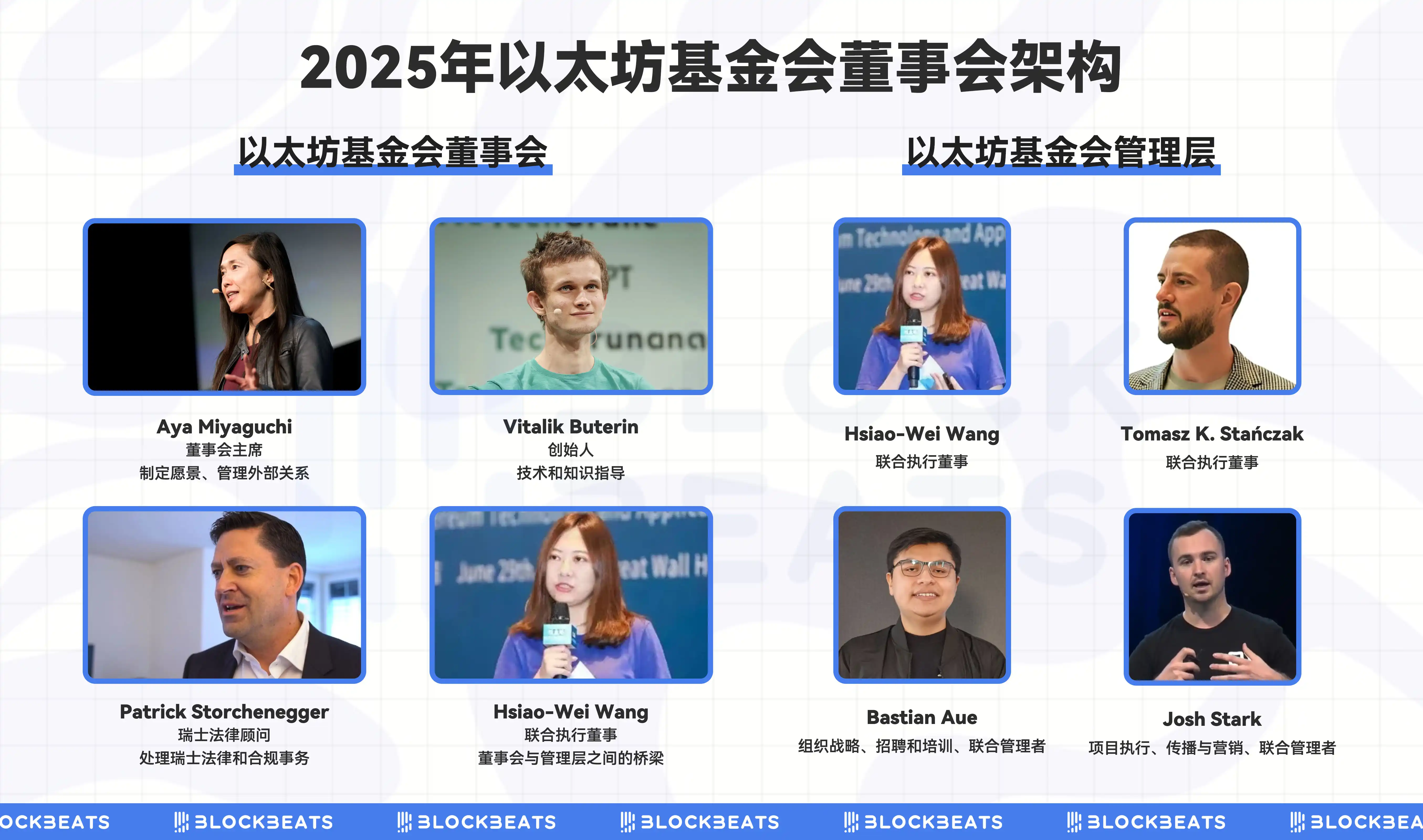
Hsiao-Wei Wang started as a backend engineer and stumbled upon blockchain in 2016. At that time, Vitalik was looking for contributors interested in Ethereum research, and Hsiao-Wei proactively applied and successfully joined as one of the core developers.
This blockchain pioneer from Taiwan has focused on core research for Ethereum for seven years, making significant contributions in the fields of sharding and the Beacon Chain. Sharding technology is a key upgrade to address Ethereum's scalability issues, significantly enhancing network throughput and making Ethereum more efficient and smooth in handling a large number of transactions. Additionally, she has long been responsible for reviewing the Ethereum protocol and developing proof of concepts (PoC), laying a solid technical foundation for the advancement of Ethereum 2.0 (Eth2).
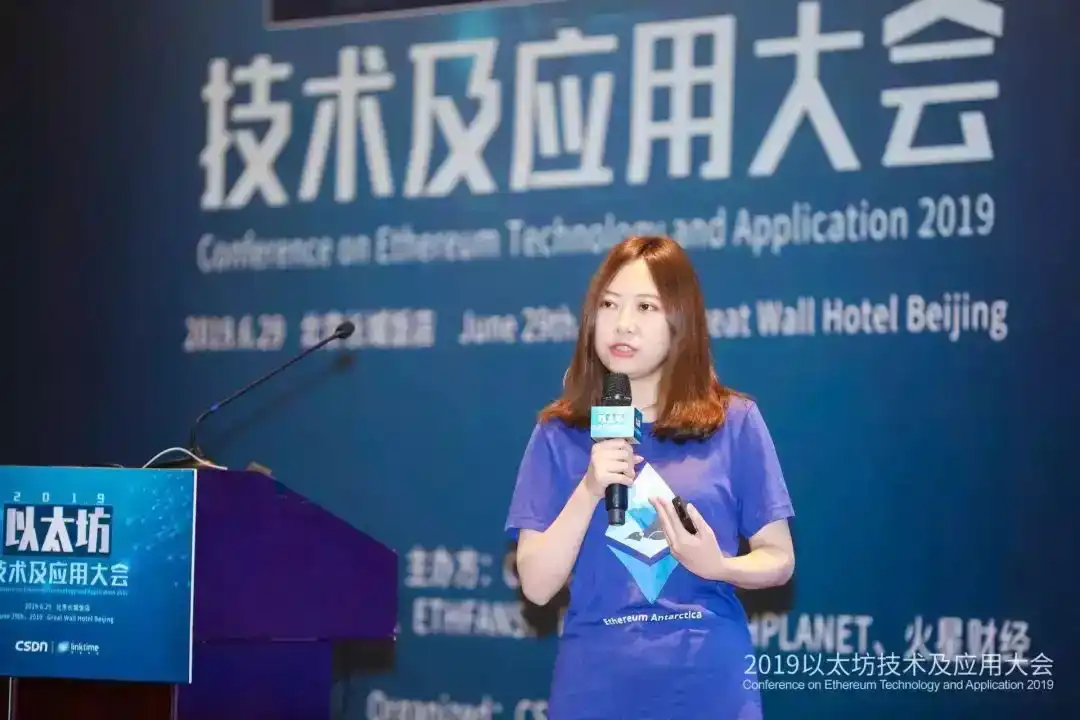
Despite her deep involvement in the technical field for many years, Hsiao-Wei has not confined herself to the world of code but has actively engaged in community building. She frequently represents the Ethereum Foundation at various technical conferences, especially in Taiwan, where she has organized and promoted many high-quality Ethereum technical exchange events, successfully bridging local developers with the global Ethereum ecosystem. For example, at the 2018 Ethereum Sharding Workshop in Taipei, she served as an organizer and played a central role in the technical discussion sessions.
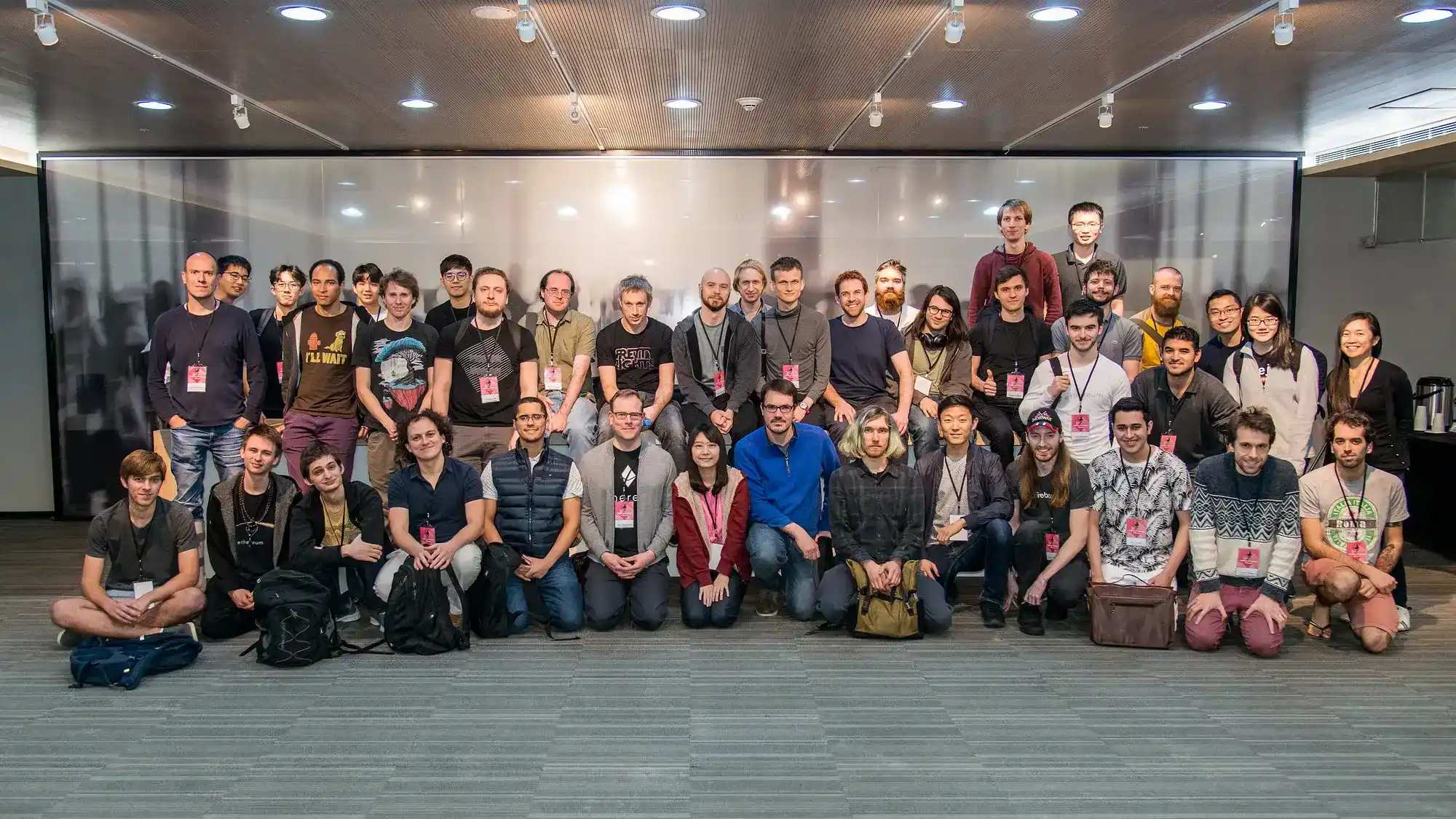
Hsiao-Wei Wang at the 2018 Ethereum Sharding Workshop in Taipei
Another co-executive director of the Ethereum Foundation is Tomasz Stańczak. As the founder of Nethermind, he is not only one of the core developers of Ethereum but has also conducted in-depth research in key areas such as MEV (Maximum Extractable Value) and PBS (Proposer-Builder Separation).
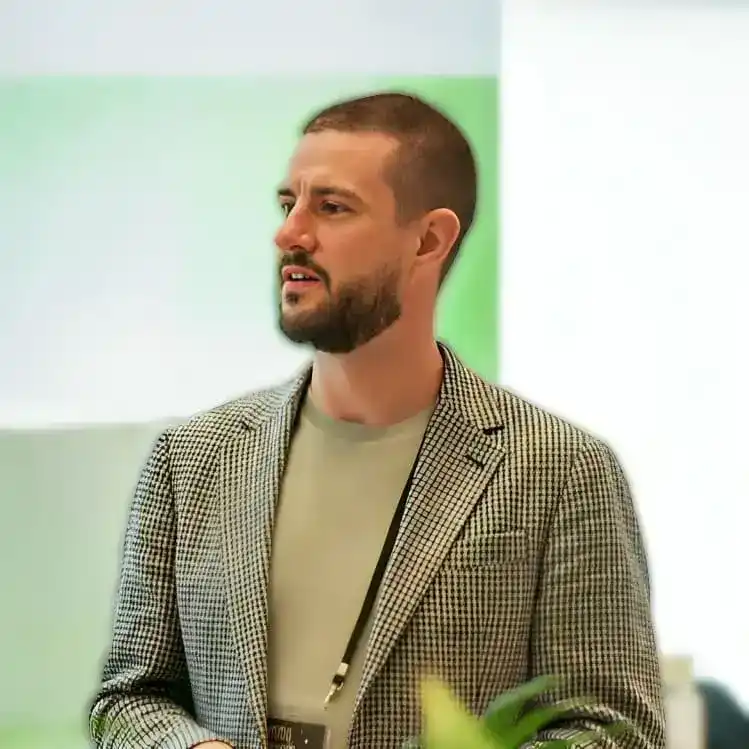
Before entering the blockchain field, Tomasz was an engineer in financial markets, possessing rich technical experience. In 2017, he officially joined the Ethereum development team as a core developer, becoming an early team member of FlashBots and a board member of the Starknet Foundation.
He later founded Nethermind, which is now one of the most important execution clients for Ethereum. Nethermind started as an experimental project but quickly grew into one of the most critical infrastructures in the Ethereum ecosystem under Tomasz's leadership, ranking alongside Geth, Besu, and Erigon as one of the top five execution clients. Compared to Geth's historical accumulation, Nethermind has attracted more developers and institutional users with its efficient code architecture, flexible customization, and strong enterprise-level support.
Hsiao-Wei Wang and Tomasz Stańczak were appointed as the new co-executive directors, and the return of former EF researcher Danny Ryan was met with cheers from the community.
As mentioned earlier, Danny Ryan is a core member of the Ethereum 2.0 team, hailed by the community as the "Chief Engineer of Ethereum 2.0." He played a crucial role in coordinating the development process of Ethereum 2.0, especially during the launch of the Beacon Chain and the merge upgrade. He was also the first Ethereum Foundation researcher to appear in the documentary "Vitalik: An Ethereum Story," and in an informal community vote regarding Ether, Danny Ryan was selected as the best candidate to serve as the sole leader of the EF. On September 13, 2024, he announced his indefinite withdrawal from Ethereum development for personal reasons, ending a seven-year career in Ethereum development. In March of this year, Danny Ryan announced his return to the Ethereum ecosystem as a co-founder of Etherealize, the Ethereum ecosystem's institutional-level marketing and product department.
The Truth About the Change of Leadership
The story of the leadership change had already been widely circulated in 2024. After the Hong Kong conference, rumors of "changing leadership in the Ethereum underground garage" began to spread.
On-chain data can detect some clues. From December 2024 to April 2025, Ethereum's price experienced a free fall, but it was also the moment when the Herfindahl-Hirschman Index (HHI) quietly turned upward.
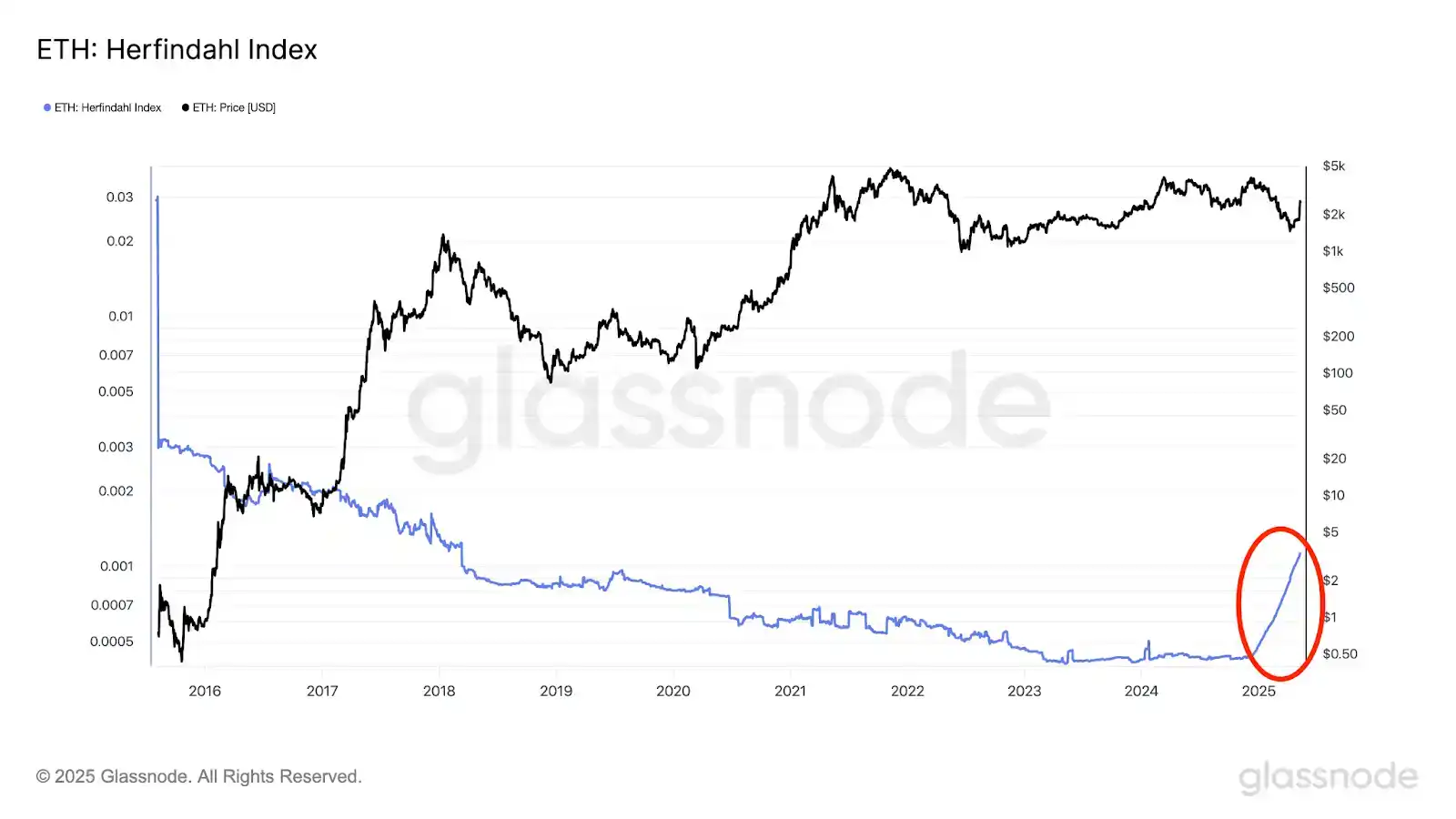
Image source: Glassnode
HHI is a measure of asset concentration, and on the Ethereum chain, it represents the trend of chip ownership. While prices plummeted, the HHI was rapidly rising, indicating that ETH was not being widely sold off by the market; instead, it was being concentrated from dispersed retail investors into the hands of a few large holders or even institutional addresses.
Beyond the data and trends, it is also evident that in the new round of price increases dominated by the narrative of crypto strategic reserves led by MicroStrategy, publicly traded companies acting as ETH strategic reserves have become increasingly common.
In May 2025, SharpLink Gaming ($SBET) announced it would raise $425 million through PIPE financing to purchase 176,271 ETH, with a market value exceeding $460 million at the time.
In June, BitMine Immersion Technologies ($BMNR) announced it would raise $250 million through PIPE financing to purchase ETH, clearly stating its intention to "transform into an ETH infrastructure asset manager." After the announcement, BMNR surged for several consecutive days, becoming another "ETH concept stock" following SBET.
Unlike SBET, BMNR is no longer just "buying and holding coins," but has clearly targeted ETH staking yields, on-chain cash flow, and participation in the DeFi ecosystem. This marks the first time a traditional mining company has transformed to go long on ETH using a "quasi-ETF logic," indicating that the mindset of the market makers has shifted from directional betting to structural capturing.
Almost simultaneously, BTCS ($BTCS) did not publicly announce how much ETH it bought in one go but emphasized the innovation of its financing structure: a hybrid financing model of "DeFi + TradFi." It is not just buying ETH but acquiring a stablecoin liquidity anchor asset.
Bit Digital ($BTBT) also quietly disclosed its purchase of 20,000 ETH, planning to transition from a BTC mining company to an ETH staking node operator. In this leadership change, some players from the BTC camp have already begun to stand on the other side.
From SBET firing the first shot to BMNR, BTCS, BTBT, and other U.S. stocks and mining companies taking turns, the entire process took less than a month, with a rapid, clear, and orderly rhythm.
It is also noteworthy that the largest publicly disclosed individual shareholder of the largest ETH strategic reserve company, SBET, is none other than Joseph Lubin, one of Ethereum's eight co-founders. As mentioned earlier, he left Ethereum due to differing philosophies and later founded ConsenSys. Joseph Lubin not only holds a significant amount of Ethereum but also became the chairman of SharpLink's board after investing, holding 9.9% of SBET's shares.
Interestingly, at the EthCC7 conference in Brussels in July 2024, after Vitalik's speech, the three core founders of Ethereum—Vitalik Buterin, Joseph Lubin, and Gavin Wood—completed a historic group photo, marking a dignified closure and reconciliation to their past "breakup."
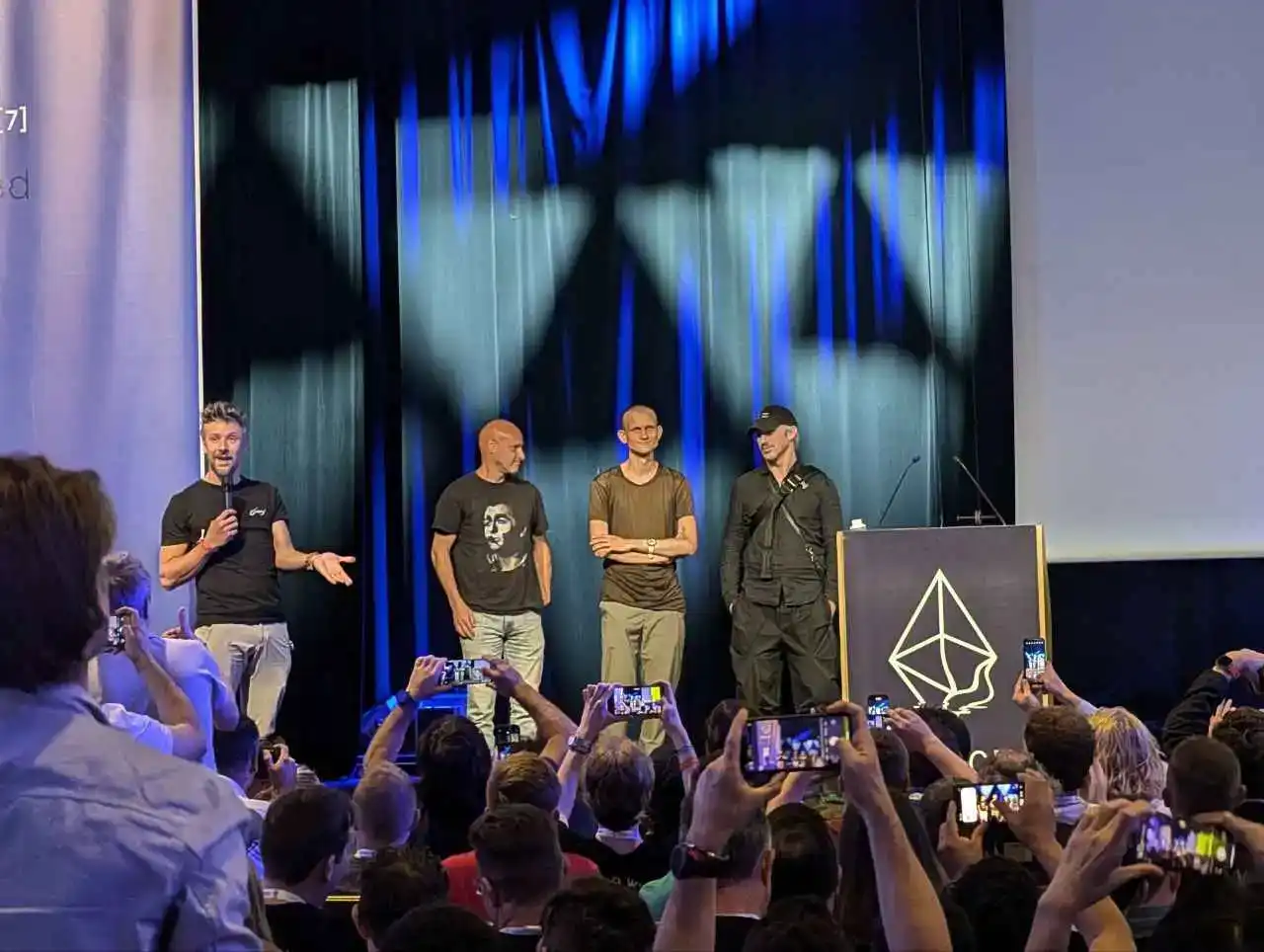
Ethereum Without Vitalik
In the memories of Vitalik's father, when Ethereum was first established, Vitalik did not envision taking on a leadership role; his thoughts were more along the lines of, "Hey, I came up with a cool idea; let me write it down, and maybe some smart and influential people will do something with it."
But then, things changed. Many people joined the project and told Vitalik, "You should be the one to push this project forward." Thus, he was pushed into a leadership position, but this was not a natural progression for him; it was outside his comfort zone and remains one of his greatest challenges.
"Vitalik has almost perfectly satisfied our society's deepened image of tech founders, the youthful admiration, and the obsession with a certain innocence combined with powerful capabilities," as noted by economics professor Nathan Schneider, who has interviewed Vitalik multiple times.
But in 2025, Vitalik is 31 years old.
While in Montenegro for Zuzalu, he saw people ten years younger than him taking on leadership roles in various projects, either as organizers or developers; at a hacker gathering in South Korea with about 30 people, he became the oldest person in the room for the first time.
Vitalik has fulfilled the imagination of a large number of programmers regarding their ideal self—young and legendary. Vitalik is a symbol; no longer young, he is no longer suited to play such a role, and he is aware of this.
Ten years ago, he thought about doing something cool, and many praised him as one of those world-changing, impressive, young prodigies like Zuckerberg. Now, after experiencing the changes of the crypto era, the Russia-Ukraine war, and the struggles of survival, Vitalik has gained new insights: "I am now playing a completely different role; it is time for the next generation to take over what once belonged to me."
"I am curious if Ethereum can survive without Vitalik's leadership?" Previously, a related discussion thread on Ethereum Reddit sparked much debate: "In the past few years, Vitalik has not led Ethereum as people imagined," and "I even heard that Vitalik is not even the best person to explain Ethereum's roadmap."
Marcocastignoli, who works at the Ethereum Foundation, also expressed his personal view: "Although I am not one of them, I know that Vitalik is just one member of the EF research team, which consists of a group of very smart minds, and Vitalik is just average among them."
Several new core members mentioned earlier have gradually emerged as core developers within the Ethereum community.
Moreover, according to statistics from Electric Capital, there are currently as many as 99 active core developers in Ethereum, a figure that far surpasses other blockchain projects like Bitcoin, Cardano, EOS, or Tron. Looking at a broader scope, the Ethereum network now boasts over 250,000 developers and researchers, making it one of the most decentralized blockchain development communities.
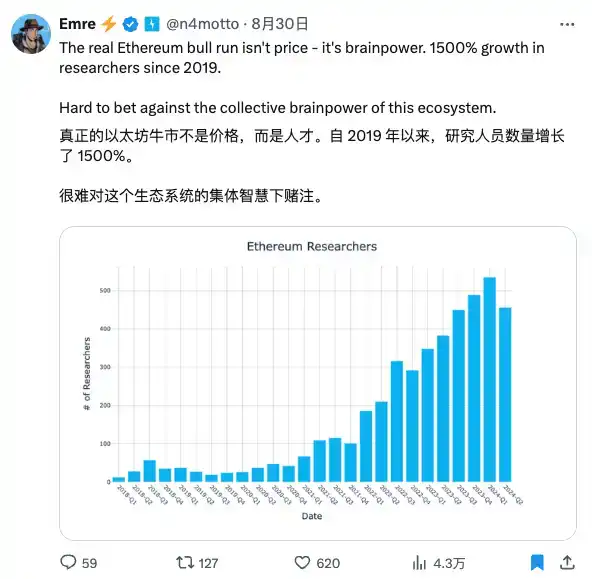
In his youth, when Vitalik was abandoned by Blizzard, he could create a new world with his technology, as if everything was created by technology. However, after experiencing several rounds of reshuffling among Ethereum team members, he found himself finally powerless; Vitalik's self began to be deconstructed from this point.
As he wrote at the end of his reflections at 30: communities, ideologies, "scenes," nations, or very small companies, families, or relationships—are all created by people.
Not created by technology. Moreover, Vitalik is no longer the youngest, smartest, or even the most representative technical researcher of the roadmap in Ethereum. Vitalik's role will continue to diminish, and one day, Ethereum will exist without Vitalik.
Perhaps it is time to imagine an Ethereum without Vitalik.
Author's note: This article attempts to summarize the changes in the core organizational members of Ethereum, but the members of Ethereum are much richer than I know. Putting them all into one article structure requires omitting many details, so there are some omissions. Thanks to everyone who provided information and other feedback.
免责声明:本文章仅代表作者个人观点,不代表本平台的立场和观点。本文章仅供信息分享,不构成对任何人的任何投资建议。用户与作者之间的任何争议,与本平台无关。如网页中刊载的文章或图片涉及侵权,请提供相关的权利证明和身份证明发送邮件到support@aicoin.com,本平台相关工作人员将会进行核查。




